My Husband’s First Furniture Makeover
Today’s makeover is a little different than normal. This time, my husband, who has never worked on a piece from start to finish, is going to take you through his very own furniture makeover.
Find more DIY dresser makeovers here!

This is the dresser that we bought from Facebook Marketplace.
I think he has only ever used a paint sprayer that I had set up, once or twice. And that was probably 7 years ago.
Sometimes he helps with some things like cleaning or scuff sanding, and he always helps with moving and lifting the furniture. But the painting and finishing are always my job.
Of course, I was around to help him out…and stress him out… haha He’s such a good sport!
So without further ado, here’s how it went down.
Supplies Used for my husband’s first furniture makeover
As an Amazon Associate, I earn from qualifying purchases. I also may earn from other qualifying purchases with other companies or get free product to review and use. All opinions are my own.
- Krud Kutter
- Shop Vac or Vacuum
- Painter’s Tape
- Pre-Taped Painter’s Plastic
- Citristrip Stripper
- 0000 Steel Wool
- Mineral Spirits
- 220 Grit Sandpaper
- 400 Grit Sandpaper
- SurfPrep Sander (Use code RAY10 to get 10% off your order)
- Bondo
- Wood Filler
- Tack Cloth
- Disposable Gloves
- BIN Shellac Based Primer
- Sherwin Williams Mohair Paint Roller
- Clear Shellac in a Spray Can
- Sherwin Williams Emerald Urethane Trim Enamel Paint
- Paint Filters
- HomeRight Super Finish Max Paint Sprayer
- Respirator
- Behr Water-Based Wood Stain-Special Walnut
- Lint Free Rags
- Minwax Polycrylic Spray Can
- New Knobs and Drawer Pulls
Here is the makeover in my husband’s words.
Preparing The Dresser For Paint
First, I removed the old hardware. There was a metal plate attached to the dresser, and I removed that too.

Then I cleaned the dresser with Krud Kutter and a damp rag. After that, I pulled out all the drawers and vacuumed out all of the nasty dust and the spider webs inside the dresser.
I help with cleaning the inside of the dressers often since my wife hates the thought of being surprised by a spider…so I was still in my comfort zone while doing this part of the process…haha
Learn more on how to clean furniture before painting here.
Removing The Old Damaged Finish

Before we went any further, we knew we had to do something about the damaged finish on the top of the dresser. So we taped things off and stripped the top, as well as 2 of the drawers.

I ended up needing 2 coats of the chemical stripper to get most of the old finish off.
After the wood dried, there were a few stubborn spots that I had to sand down to bare wood. But then I finally had a nice smooth wood surface!
Find step-by-step instructions on how to remove wood stain right here! Check out the best tools for removing paint or old finish from wood here.
Repairing Veneer
Then, before we could dive into painting, we still had a lot of repairs to make on a lot of chipped veneer at the base of the dresser.

So we flipped the dresser upside down and chipped off all of the loose pieces of veneer. Then I filled in all of that veneer with Bondo.

I made a newbie mistake and let the Bondo harden too fast, so I had to mix another batch of Bondo together to fill in the rest of the chipped veneer.
Once the Bondo was completely dry, I used our sander to sand all the excess Bondo off.
Check out my honest Bondo wood filler review here.
See the full tutorial on how to fix chipped wood and repair damaged veneer here! And learn about the best sanders for furniture in this post!
Get the Secrets!
Grab this super convenient How to Repair Furniture Ebook with all of our secrets on how to repair furniture for only $14.
You can print it out and have instant access whenever you come across damaged furniture, and know exactly how to fix it!
Click on the picture of the book to purchase!
Filling Scratches And Dings
Then I used wood filler to fill the smaller scratches and dings on the dresser, and a few spots on the Bondo-ed areas. Learn about the best wood fillers for furniture here.
After the wood filler was dry, I sanded the wood filler down, and scuff-sanded the rest of the dresser. Read this post to learn about the importance of sanding before painting furniture.
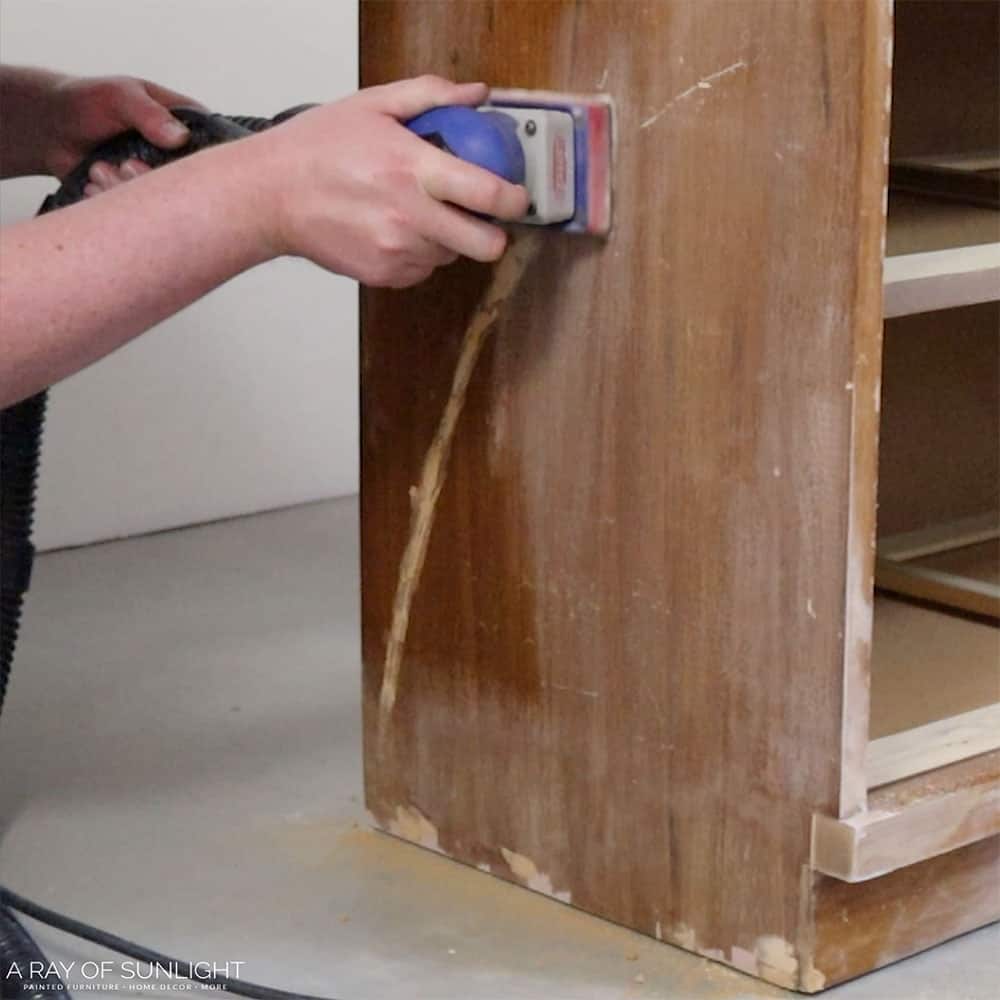
And then I vacuumed everything off and wiped it down with a tack cloth to get all the dust off.
Rolling Primer onto Dresser
Then it was time to prime. We used BIN shellac based primer that my wife got tinted grey-ish.
((I’ve never been able to get the paint department to tint BIN for me, but this time they agreed to try. It may not be the prettiest color ever, but they tinted it darker, and that was good enough for me.))
I rolled the first coat of primer onto the dresser, letting it dry for one hour between coats. Learn all about the best rollers for painting furniture here!

There was more texture than I wanted when it dried, so I sanded the texture out a little bit. But I sanded back down too far and into the wood. Another newbie mistake! haha
You should also remember these five furniture makeover mistakes to avoid for a successful painting project.
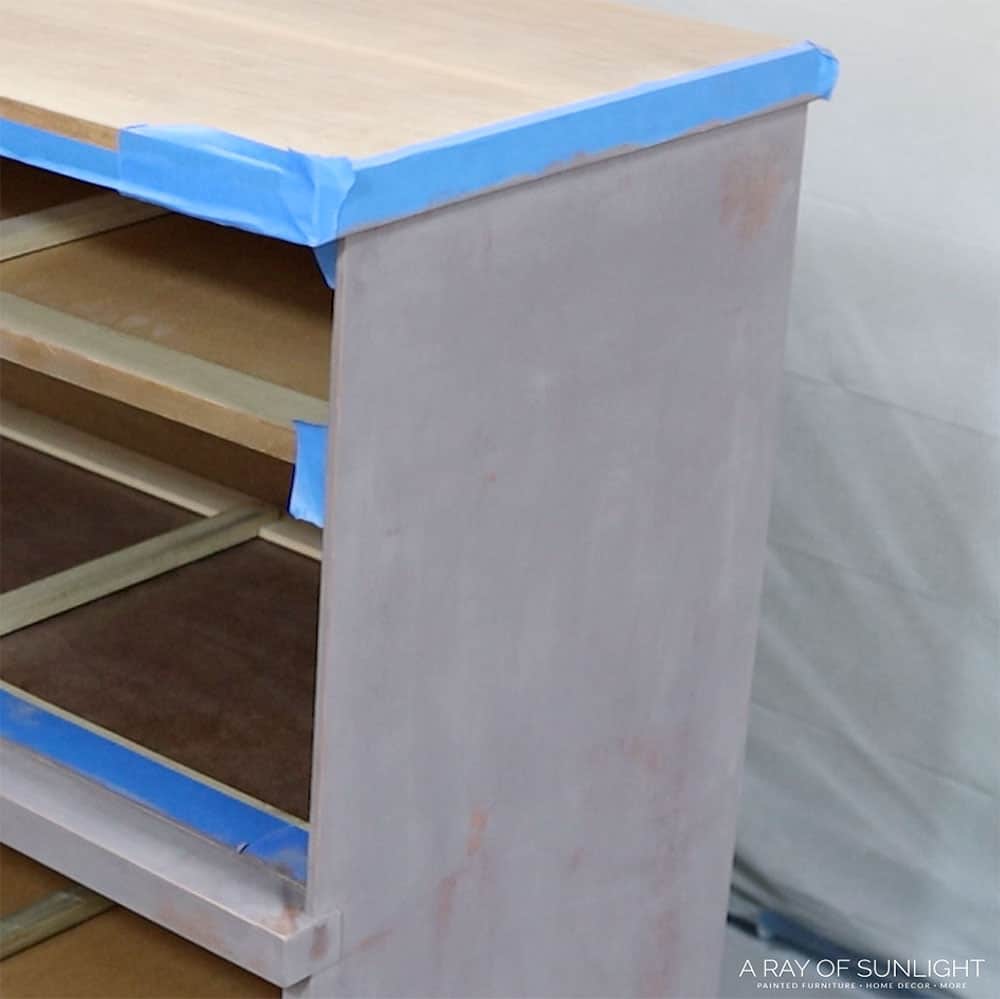
Then I repeated the process of vacuuming and using a tack cloth to clean up all the dust.
And I painted another coat of primer on it. This time I tried having only a tiny tiny bit of primer on my roller… and it came out so much better. There was still a little bit of texture, but definitely not as much as before.
And then this time, when I sanded the texture down, I sanded it by hand with 220 grit sandpaper because I was worried I would sand through the primer again.
Learn more about sandpaper for furniture painting here.

I was able to control how much I sanded so much better than before! And then I cleaned it all off again.
I also sprayed clear shellac on the top and the two other drawers that I planned to stain. Natalie said she has heard that it helps the wood stain soak in more evenly, so I thought I would try it.
Read this post to learn more about the best primers for painting furniture (and how to choose the right one).
Spraying Paint onto Dresser
Okay so after stressing out a little through ALL of that priming, I was finally ready for the paint. I used Sherwin Williams Emerald urethane trim enamel in this color that doesn’t have a name.
Check out my honest Sherwin Williams Emerald Urethane Trim Enamel Review here.
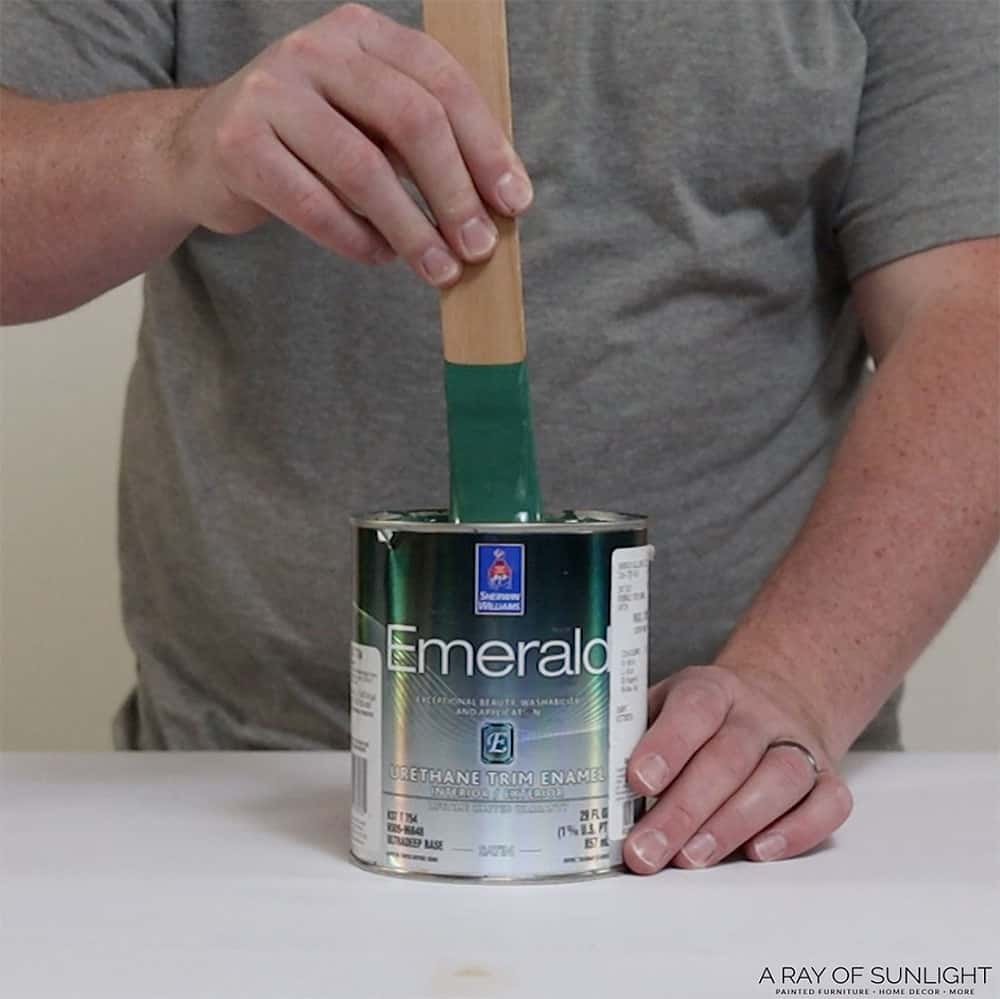
((I thought that this paint would be easier for him to use, instead of a paint that requires a topcoat. Sometimes topcoats are such a pain, especially on dark colors.))
I thinned paint out by about 10% and filtered it through the paint filter like Natalie says to do. Then I put the red 4mm tip on the HomeRight paint sprayer and tested out the spray.
Learn more about the HomeRight Super Finish Max paint sprayer here. Check out my guide on how to clean HomeRight paint sprayer here.

Remember this is my first time really using a paint sprayer to paint a piece of furniture and I was actually pretty nervous!
Just ask Natalie how many questions I kept asking her throughout this whole process! Haha
((And how many times did I say, “watch my video. It’s all in there.” haha I really wanted him to try spraying without extra help from me.))
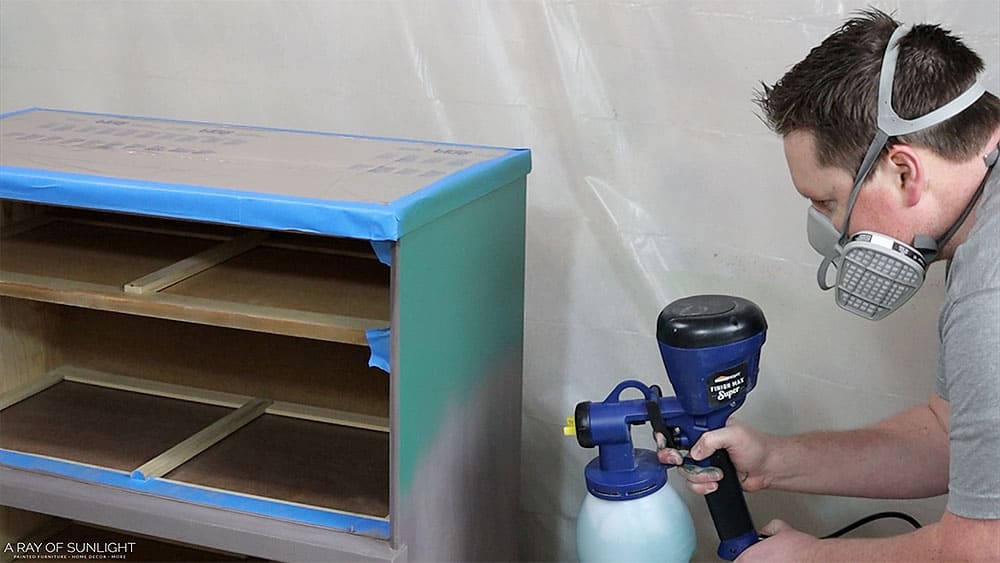
So I got started spraying the 1st coat and it took some getting used to, but by the end of the first coat, my confidence was growing.
Here’s what the 1st coat looked like while it was still wet.

Turns out I sprayed a little too lightly and the paint was more textured than I wanted, but overall it still looked pretty good. When the first coat was dry I sprayed the 2nd coat.
This time I adjusted the paint sprayer to spray a little heavier to try and get a slightly thicker coat of paint in hopes that it would self-level better for a smoother finish.
Learn more about painting furniture with enamel paint here.
Priming Top of Dresser
And then my wife took the plastic off the top to get a good look at the whole thing.
((And, not to Taylor’s surprise, I told him I didn’t like it. The stained top and the stained drawers needed something green in between them. OR one of them needed to be painted.))
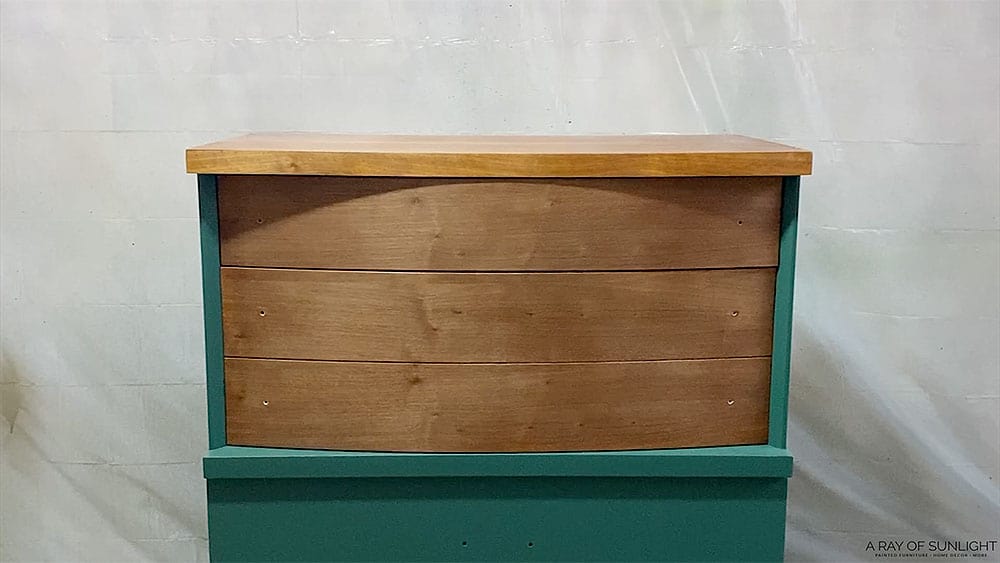
Once she pointed it out to me, I agreed… so we went to plan B. And I primed the top of the dresser. I ended up giving it 4 light coats of primer.
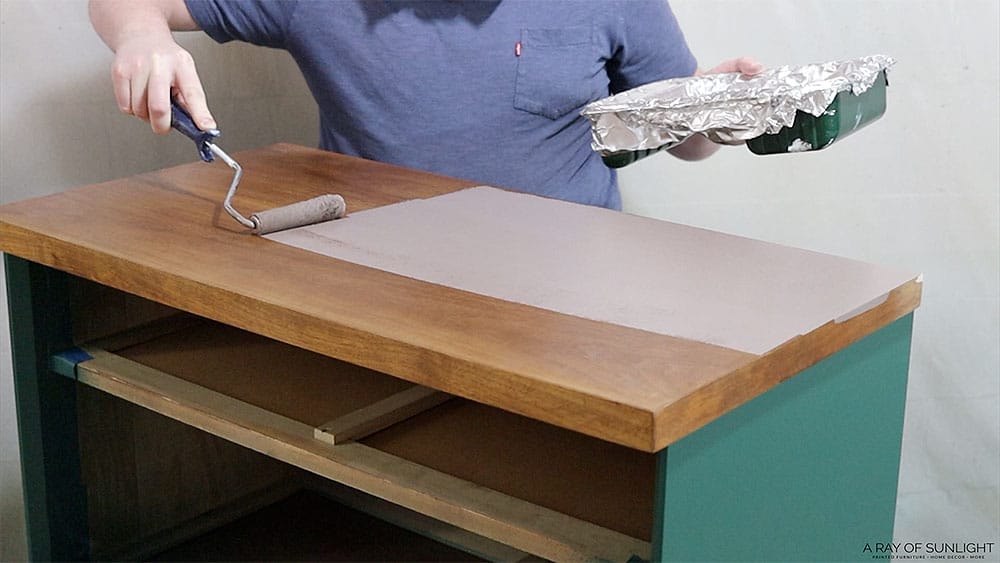
I was trying to roll it on thin so there wasn’t much texture left behind, but then Natalie noticed that the wood grain wasn’t filled in after 2 coats.
So I rolled on more primer to try to fill in the deep wood grain. Read this post to learn more about how to hide wood grain when painting.
Sanding Dresser For A Smooth Finish
Then it was time to sand and sand some more! I sanded everything (but the other 2 drawers down) with 220 grit to remove most of the texture and make it feel smoother.
And I sanded it by hand because I didn’t want to sand too much.
Since I had to put paint in the sprayer again, I figured that I might as well try to get an even smoother finish on the body of the dresser than before.
Then I vacuumed and used a tack cloth to get the surface all clean again.
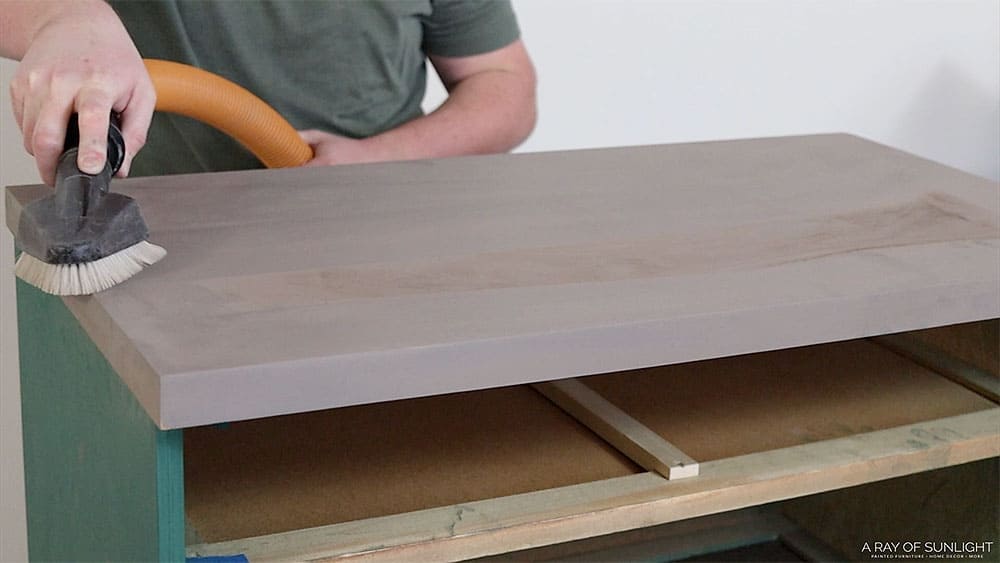
Spraying The Top And The Rest Of The Dresser
This time, when I mixed up the paint, I thinned it out by 15%, in hopes that it would create a smoother texture than before. So we added 16 oz of paint to 2.5 oz of water and mixed it very well.

We used the 4mm tip on the paint sprayer again. Then I tested the sprayer, adjusted the spray volume to where I was comfortable, and sprayed one coat on the top.

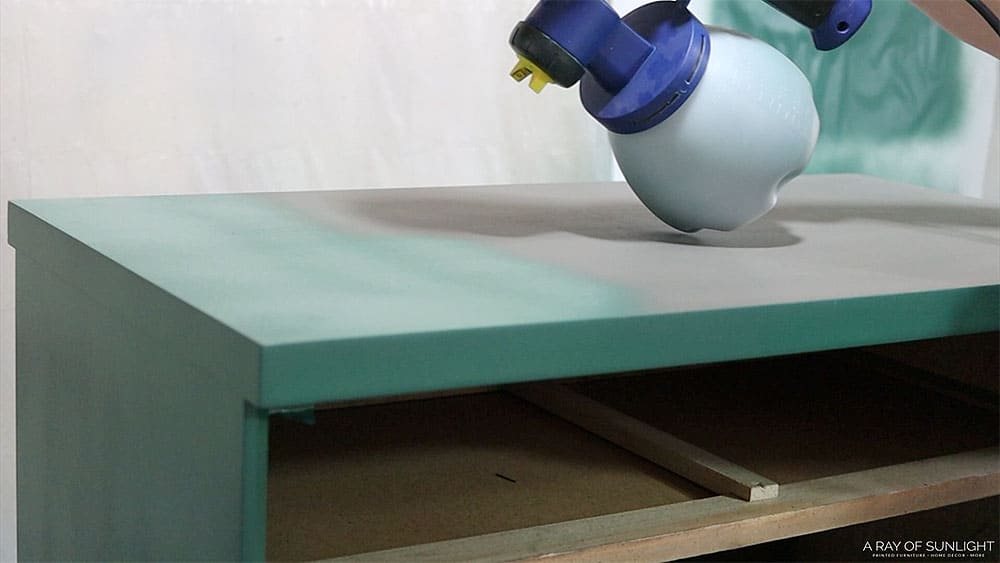
Halfway through, the sprayer started acting up on me and wasn’t spraying as much paint out as before. So the finish didn’t look very good.
So I took the sprayer apart, cleaned out the 4mm tip, and got it spraying good again. Learn all about how to clean a paint sprayer here!
Or check out the spray paint tools you need when painting furniture here.
But first, before doing another coat of paint, I lightly sanded the drawers and the top to smooth out the texture again. Then I cleaned off the dust again. And I sprayed all of the dresser with another coat of paint.
The sprayer started to spray less and less paint again as I was getting close to the end. So the top and the drawers still didn’t have a really nice-looking finish.
So I messed around with the sprayer’s tip again, until I got it to work. While that last coat of paint dried, I worked on staining those two other drawers.
Staining Wood Drawers
I lightly sanded the drawers with 220 grit sandpaper just to make them feel smooth again. Then I cleaned off the dust.
And then I stained the drawers with Behr water-based wood stain in special walnut. Check out the best wood stains for refinishing furniture here. Learn more about how to stain wood darker here.

I wiped the stain on with a lint-free rag and then used a clean lint-free rag to wipe away the excess. With my wife coaching me, I tried to wipe the stain on and off in long, even strokes that went with the grain of the wood.
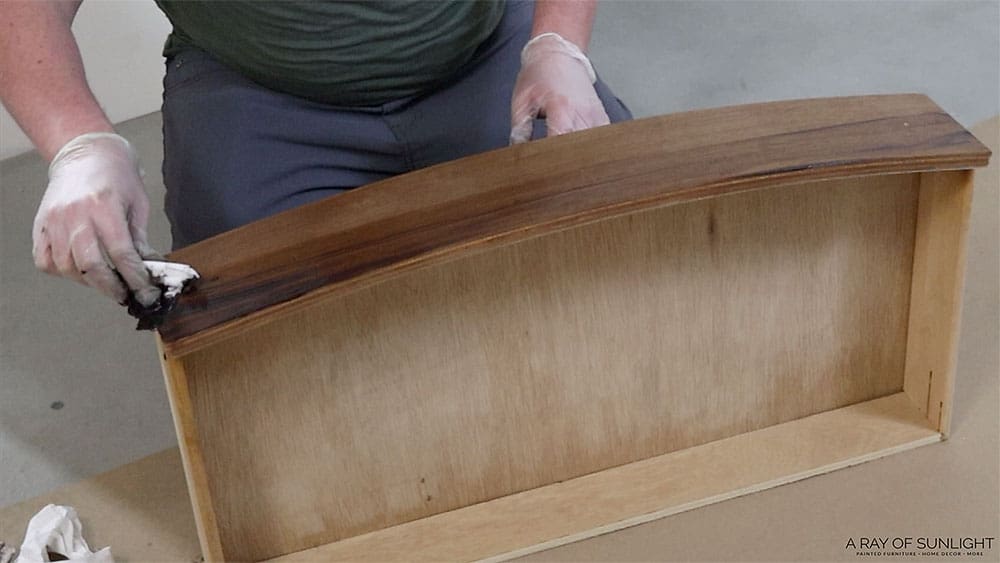
((Yeah, you were stressing me out there a bit. Haha But you did a good job.))
The stain was dry after an hour and it looked so good. Click here to learn more about applying water-based stains.
Topcoating Stained Drawers
So I sprayed on 3 coats of Minwax Polycrylic in the spray can, letting it dry for 30 minutes between each coat. That stuff sprays like a dream. And it looks and feels SO GOOD.


The stained drawers were done and looked great, but I wasn’t quite done.
Learn more about the best topcoats for painting furniture here! And here’s how to apply polycrylic to painted furniture.
Applying Final Coat of Paint
I went back to the dresser and lightly sanded those drawers one more time. After cleaning them off, Natalie gave me the idea to put them back into the dresser.
((Sprayed paint dries so much smoother when it is on a vertical surface. The sides always feel smoother than the top. I guess that’s another reason I spray with the drawers in.))
Then I sprayed one last coat on the top and the drawers.

When all was said and done, we ended up with a total of 5 coats of paint, 6 coats of primer, 1 coat of stain, 3 coats of poly… oh, and 2 coats of stripper in the beginning.
Adding New Dresser Hardware
After everything was dry, I put the new hardware on.

They matched up with the previous holes in the drawers, so we didn’t even need to measure and drill new holes! That’s a win, win for me!
But if you ever do come across a project where you need to make new hardware holes, just check out this post to learn all about how to change hardware on a dresser!
Watch the whole process of my first furniture makeover here:
So after a lot of trial and error on my part, here is what my first-ever dresser makeover looks like now!
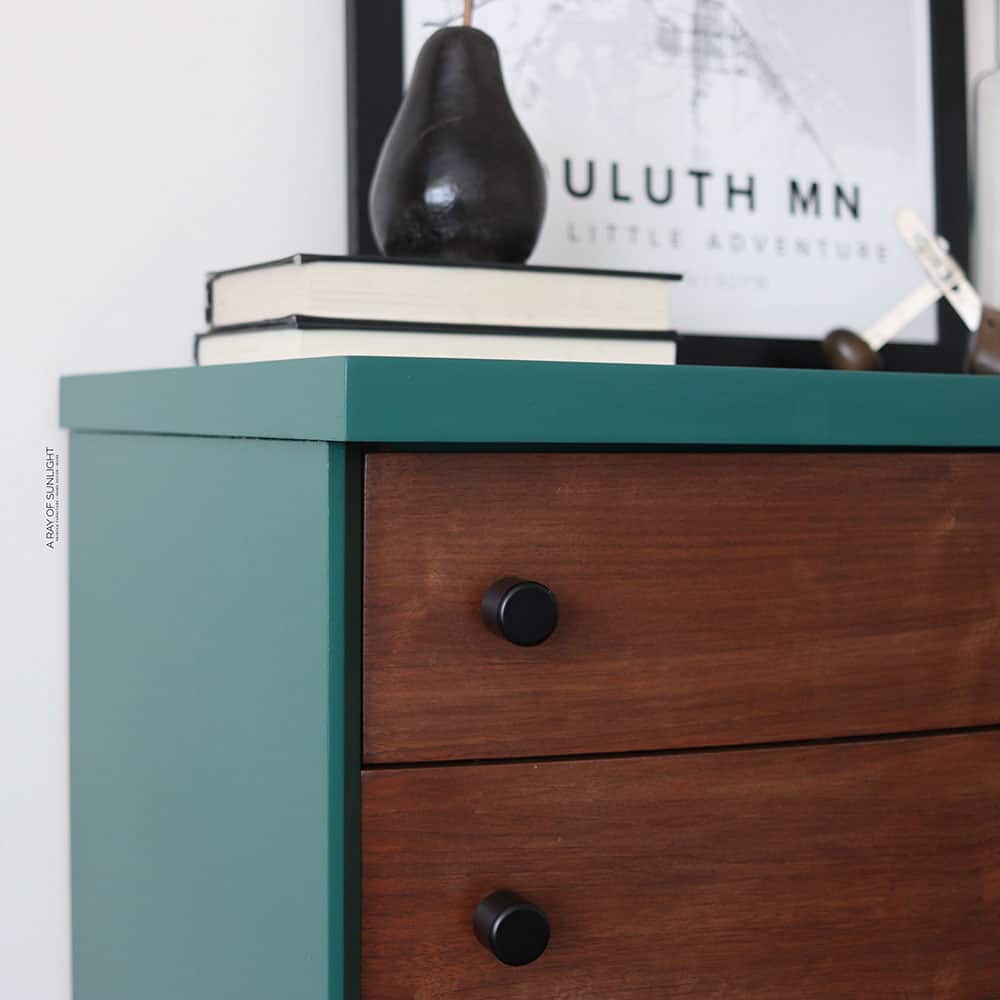

More Before And After Makeovers
Click any of these “before” photos below to view the “after” of that makeover.

Overall I am really happy with how it turned out considering I am a total newbie at this.
My favorite part was using the Minwax polycrylic. It was so easy and it looks so good.
Spraying stressed me out a bit because I didn’t want to mess it up and have to sand more. It didn’t help that the sprayer was giving me fits.
But I’m looking forward to trying it again. And hopefully, the sprayer works better next time. Check out the best HVLP paint sprayers for furniture here.
I didn’t like all of the sanding, but I think it was worth it to make a smoother finish.
I really wanted to keep the top stained, but I think it does look better overall with the painted top.
Wondering is two-toned furniture in style? Check out this post with a makeover guide to learn more.
What do you think? I hope you liked this makeover, see you next time!
More Painting Furniture Tips
- Painting Furniture
- Chalk Painting Furniture
- Painting Furniture with a Sprayer
- Best Painting Furniture Supplies
- How to Prevent Overspray When Painting Furniture
Follow us on YouTube to get more tips for painting furniture.
Or share your project with us on our Facebook Group and be part of our community. See you there!


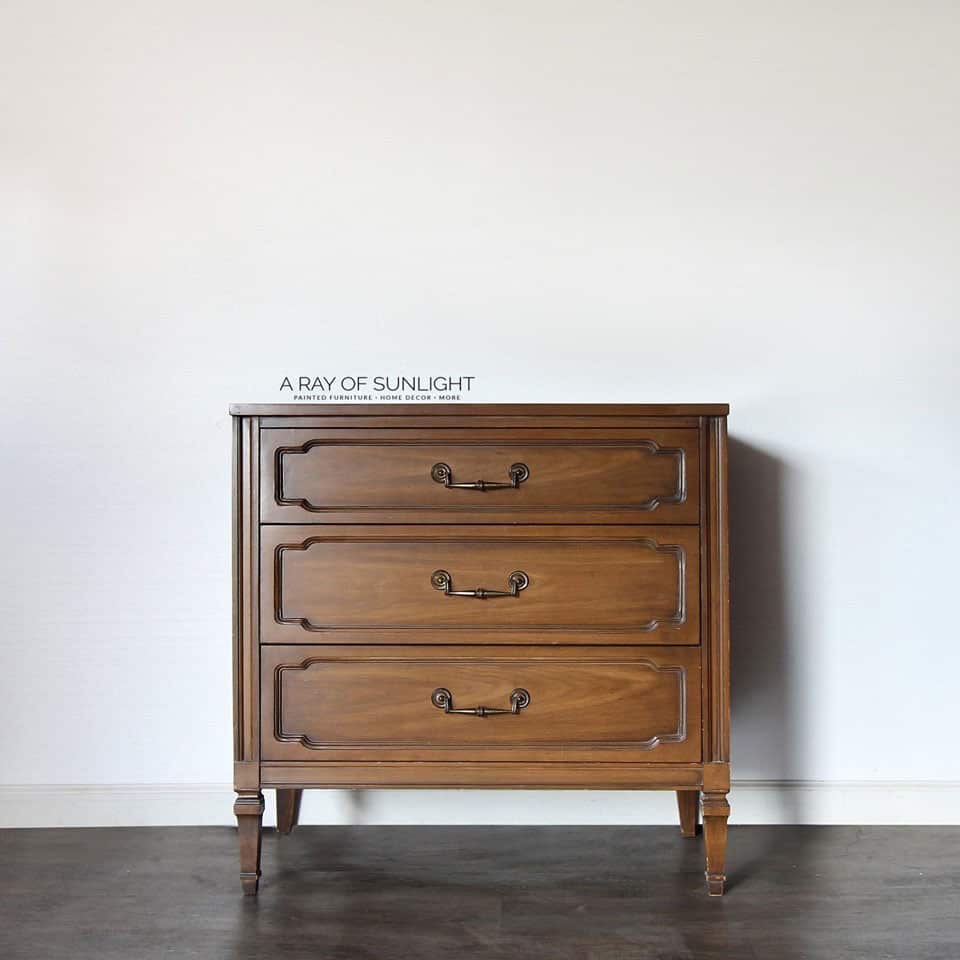






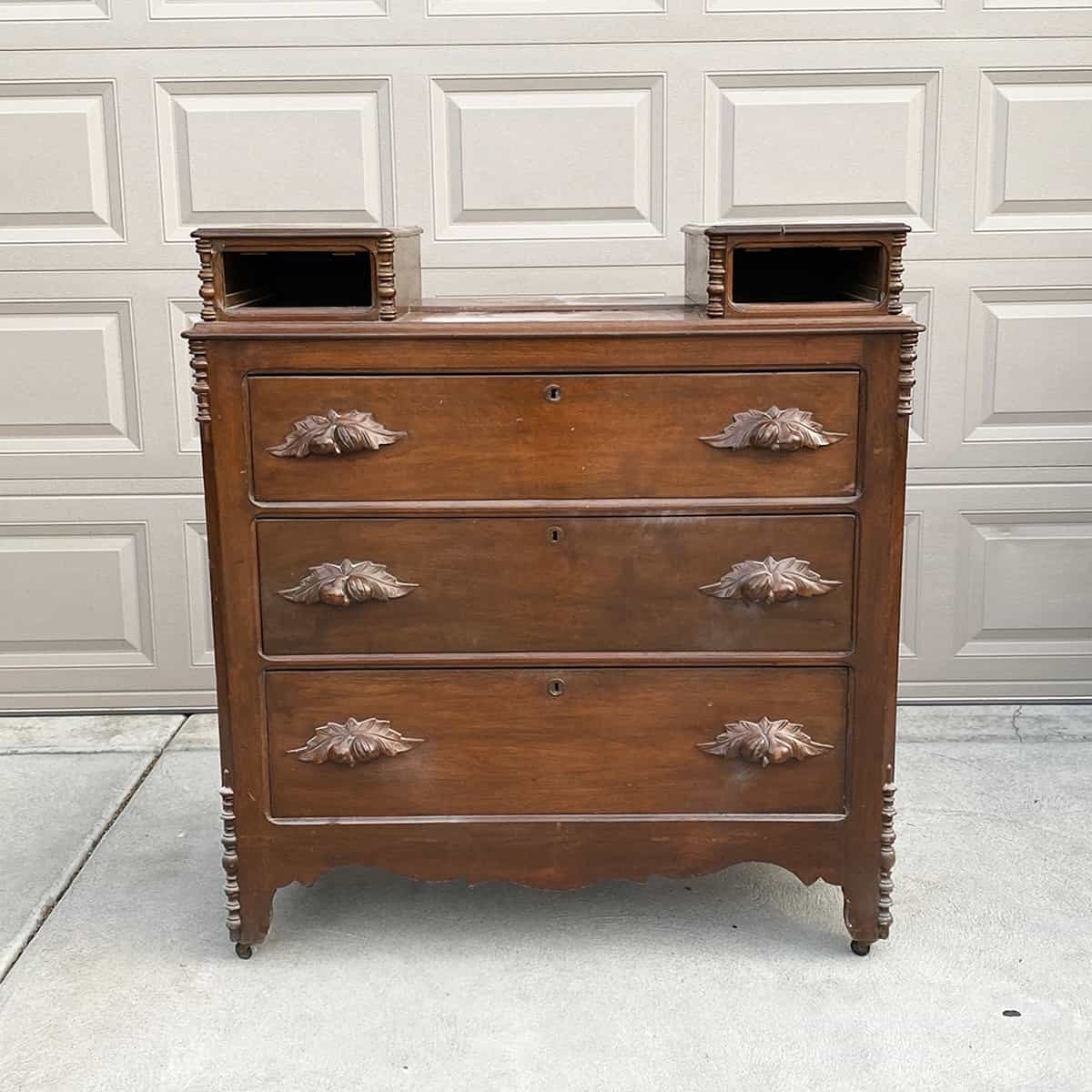
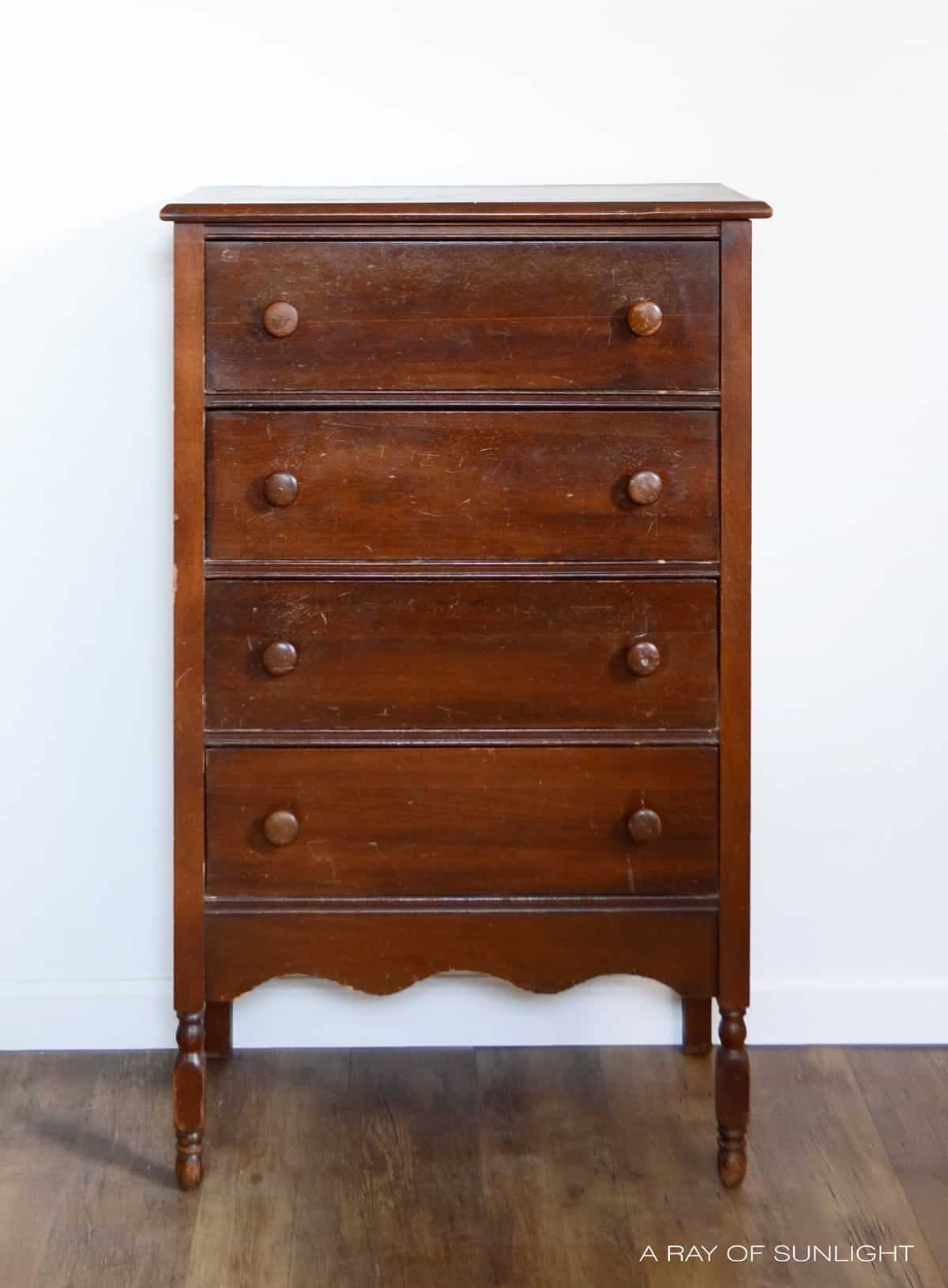
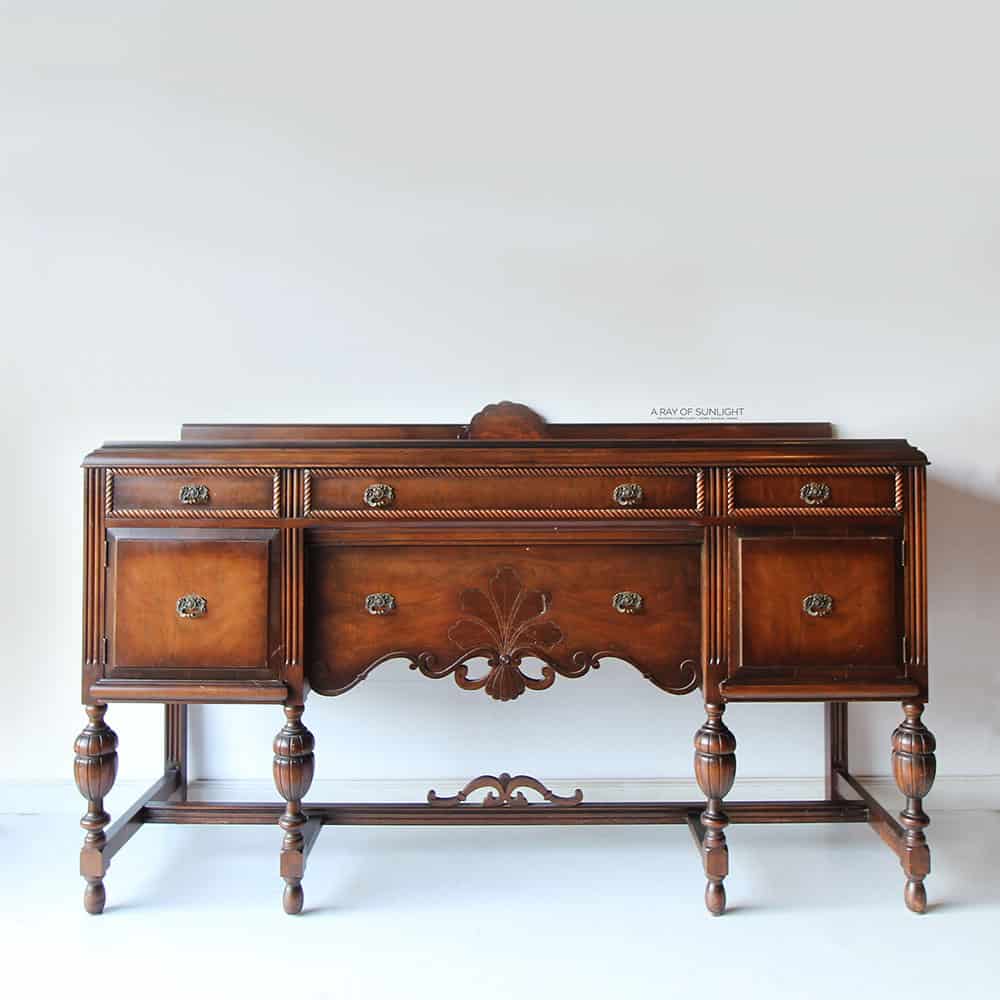

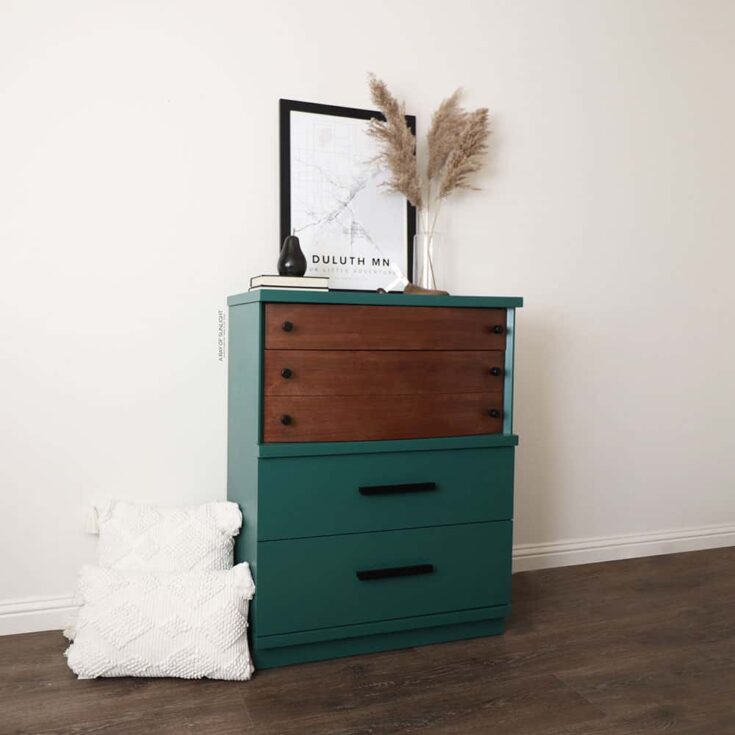





It looks great, but you have a good coach! I would have stained the top the same as drawers and painted the trim around the edge green to frame it in. I like the dark pulls.